|
ICC |
UNIVERSITY |
GHENT |
HOTELS |
ROUTE
DESCRIPTIONS |
|
International
Congress Centre of Ghent
|
|
History
of the ICC
The ICC
Congress Centre was built in the seventies. Even in those days it was
one of the major congress centres in Belgium, thanks to its large
auditorium of 900 seats and two break-out rooms.
Unfortunately
no provisions were made for catering, so that users of the centre were
left to find their own solution for coffee breaks and meals.
Today the ICC
has been completely renovated and enlarged. Even the smallest details of
the aesthetics of the building and of its practical lay-out have been
rethought and redesigned. The result is the most advanced congress
centre in Belgium, accommodating group activities of up to 2,000
participants. For successful meetings, staff parties, seminars or
congresses without the slightest stress, the ICC is the place you need.
Congress
Valley has run the ICC since the beginning of 1999. The principal
shareholder’s main assets are his financial strength, his know-how and
his experience. This combination is a sure guarantee of a successful and
modern congress centre and provides a new élan to the Citadel Park and
the city of Ghent.
The Main
Congress Hall has been equipped with the latest technical facilities,
which allows every kind of organiser to highlight his event in his own
specific way.
The most
impressive application of the centre is the catering unit, which
includes the fine Banqueting Hall.
http://www.icc-gent.com
|
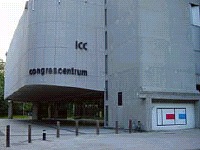
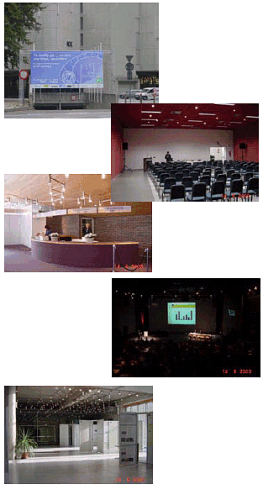
|
|
History of the University
of Ghent
|
|
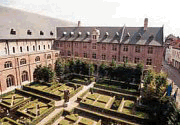 The
university of Ghent is situated in the historical building 'Het Pand'.
'Het Pand'
is an old Dominican monastery located in the heart of the city on the banks of the river Leie, near the medieval port with the guildhalls as its
remnants. The
university of Ghent is situated in the historical building 'Het Pand'.
'Het Pand'
is an old Dominican monastery located in the heart of the city on the banks of the river Leie, near the medieval port with the guildhalls as its
remnants.
In 1201 a hospital was established next to Saint Michael's Chapel by Canon Utenhove. By 1225 the institute had become too small, and it was decided to construct a new one close to the Bijloke .By that time the first Dominicans had arrived in Ghent. By the agency of the then counts of Flanders, Ferdinand of Portugal and Johanna of Constantinople, the Dominicans were allocated the old hospital to serve as their new
settlement. The year 1228 is considered to be the official date of establishment of the monastery in Ghent. The monks were very actively constructing, and very soon they started building a fully fledged monastery. By 1240 the construction of a church was launched, and it was finished after 25 years. During the period 1325-75 the wing at the river Leie was constructed, with a sacristy, a priory, the refectory and the chapter house, a brewery and a kitchen. All over the first floor was a spacious dormitory.The corridors of the courtyard date from the 15th century, and were constructed in different
periods. In 1473 Margaret of York, spouse of Charles the Bold, laid the first stone of the street wing or library wing, which was the most important extension of the monastery. In the beginning of the 16th century the construction of the middle wing was started, using sandstone for the ground floor and bricks for the upper, and applying the Tudor
arch. The Iconoclastic Fury of 1556 brought hard times for the building. The Calvinists threw all the library books in the Leie. After a brief period of peace, in 1578the Calvinists took over the city again. The monastery was used as a Calvinist university until 1584.In 1651 the old Utenhove hospital was being pulled down and its foundations were used to construct a new hostel which was to be arranged to serve as a guest wing. The north-eastern part of the premise, with the priory and the pharmacy, was refurbished 1780-81 in Louis XVI-style, using stucco and decorative painting. The establishment of the monastery is thus spread over more then 5 centuries, the countless extensions and modifications show the busy activity of the order in the inner city.
In 1796, after the French Revolution; the monastery was closed and sold in lots. The fathers were able to purchase the building with the help of an agent. They let some part of the building to get some income, but still they were forced to sell the property in 1823, with the consent of Pope Leo
XII. The new civil owner, exploiting the rising need of housing occasioned by the speeding industrialization of the city, introduced intermediate floors and partitions. In this way, some two hundred rooms became available for those with little means, while the large rooms such as the sacristy and the chapter house were being used as depots for wine and the refectory became a 'Bazar', a market of
furniture. In 1860, the church was demolished. Plans were being made to build a bridge across the river, and an avenue to connect the Volderstraat and its prestigious Aula with the Coupure, where the better class citizens lived. These plans were never
realized.
In view of the world exhibition of 1913, some restoration was done at the Leie front in 1912. The building affected by age had deteriorated in such a way that it became untenable after the Second World War. It was prone to be
demolished. But the Decree of 29.10.1956 put the building on the list of classified premises, and the owner went searching for a potential buyer. It was a surprise when the Board of Management of the University of Ghent decided to acquire the
building. They were very much convinced of its value, and the transaction took place on January 25, 1963. It was decided to arrange 'Het Pand' as the cultural center of the university, and the Direction of the Buildings was entrusted with its renovation and restoration. Works were started in 1971 and accomplished in 1991.
Website
of the University
|
|
Ghent
|
|
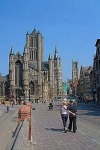 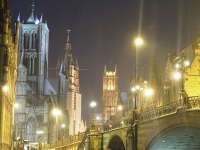 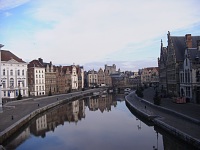 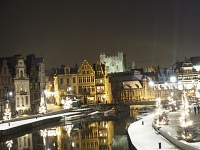 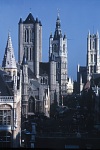
It can be no coincidence that Ghent, the capital of East Flanders, was given several pretty names: historic heart of Flanders, a city of all times, one of the most beautiful historic cities in Europe.
The city combines an impressive past with a vivid present. Numerous tourists visit Ghent of which the citizens carry the nickname "stroppendragers" or noose-bearers and use the extensive accommodation possibilities. The historic heart of the city offers a lot of places of interest. From St Michael's bridge there is a wonderful view on the skyline of Ghent with the three impressive towers of St Nicholas' Church, the Belfry with its bell tower and St Bavo's cathedral with the world famous painting "The Adoration of the Mystic Lamb" by Jan van Eyck.
Traces of the Middle Ages were preserved at a lot of places. The old port with its guild halls on the Graslei and Korenlei is merely one example of the beautiful views this town has to offer.
Not far from the Graslei arises the Castle of the Counts, once the medieval fortress of the Count of Flanders. Nowadays it is a major tourist attraction.
Ghent also has several museums, abbeys, beguinages, dozens of churches and historical buildings.
Not only art lovers but everyone can find something here to suit his taste. Ghent offers a lot of shops, restaurants and an exciting nightlife.
General information
The official language in Ghent is Dutch, but most people also speak French, English and/or German.
The Belgian currency unit is the euro.
There are exchange offices and banks in the city centre.
Credit cards are accepted in most places.
All prices in Belgium include VAT and service.
Addresses
Tourist Office - City of Ghent
Administration
Predikherenlei 2
B-9000 Ghent
Tel. +32 0(9) 266 56 60
Fax +32 0(9) 266 56 73
E-mail toerisme@gent.be
Inquiry desk
Crypt of the Belfry
Botermarkt 17A
B-9000 Ghent
Tel. +32 (0)9 266 52 32
Tel. +32 (0)9 266 52 33
Tel. +32 (0)9 266 52 34
Open
01/04/2003 - 31/10/2004
9.30 a.m. - 6.30 p.m.
01/11/2004 - 31/03/2005
9.30 a.m. - 4.30 p.m.
Closed: 25/12 and 01/01
For
more information see also the website of the city of Ghent
|
|
Hotels |
|
We made special deals with several hotels in
Ghent to you can choose from for your stay. On the registration form you
can indicate the hotel of your choise.
|
Hotel Category |
Single Room |
Double Room |
|
Marriott***** |
€ 250 |
€ 260 |
|
Sofitel **** |
€ 240 |
€ 250 |
|
NH Gent Hotel**** |
€ 140 |
€ 150 |
|
Novotel *** |
€ 155 |
€ 170 |
|
IBIS Hotel Opera ** |
€ 80 |
€ 90 |
|
IBIS Hotel Kathedraal ** |
€ 95 |
€ 105 |
Breakfast and VAT are included in the room
price.
NO CONFIRMATION can be supplied unless we receive your full payment for
the hotel.
Cancellation of the hotel accommodation is only possible before pctober
30, 2006.
|




|
|
Route
description
|
|
Click her for the printversion
From
Antwerp
E17 motorway Antwerp-Ghent Exit Ghent Centre (Gent Centrum)
Keep right (do not take the flyover; follow “all directions” (alle
richtingen) and choose left lane
At first traffic lights, go left under the flyover (St-Lievenslaan)
At second traffic lights (large crossing), go straight ahead
Right after the crossing, at the third traffic lights, you enter a small
park (Hofbouwlaan)
On your left you see the Museum of Fine Arts and on your right the
Museum of Contemporary Arts (SMAK)
About 50m on, after a wide bend, you find the entrance to the ICC on
your right (the ICC stands next to the Contemporary Arts Museum in the
Hofbouwlaan, as shown on the map)
From
Brussels
E40 motorway Brussels-Ghent
At intersection with E17 motorway (Ghent-Antwerp), take E17
Exit Ghent Centre (Gent Centrum)
Keep right (do not take the flyover; follow “all directions” (alle
richtingen) and choose left lane
At first traffic lights, go left under the flyover (St-Lievenslaan)
At second traffic lights (large crossing), go straight ahead
Right after the crossing, at the third traffic lights, you enter a small
park (Hofbouwlaan)
On your left you see the Museum of Fine Arts and on your right the
Museum of Contemporary Arts (SMAK)
About 50m on, after a wide bend, you find the entrance to the ICC on
your right (the ICC stands next to the Contemporary Arts Museum in the
Hofbouwlaan, as shown on the map)
By public
transport
The following buses stop at the entrance to the ICC (bus stop
Ledeganckstraat): lines 9, 28, 34, 35, 36, 55, 57, 58, 70, 71, 72, 76,
77, 94 and 95.
All these bus lines, and in addition lines 73 and 74, go from ICC to St.
Peter’s station, Ghent’s main railway station.
www.nmbs.be
- www.delijn.be
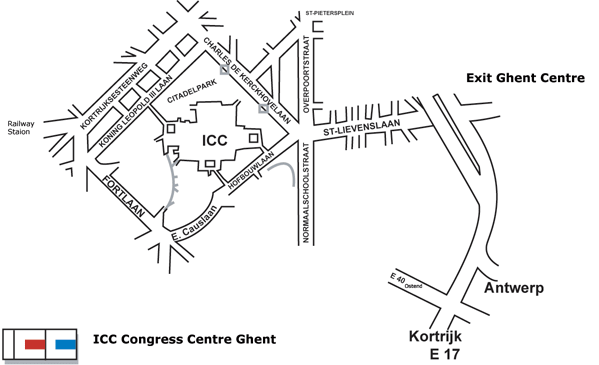
|











